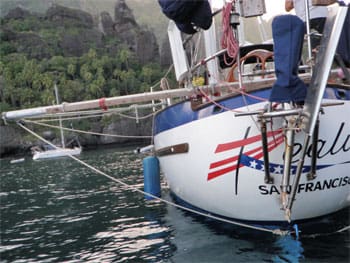Sharon and Vaughn Hampton and their crew, Dan Knierlemen, left the Galápagos on their boat, Reality, a 1982 51-foot Ta-Yang FD-12, bound for the Marquesas. The passage involved 3,100 miles of downwind sailing with winds ranging from 10 to 25 knots and seas from five to 10 feet — typical coconut milk run conditions.
Six hundred and fifty miles into the trip, Sharon noticed that Reality was not holding her course. The autopilot stopped working. After a few attempts to stop and restart the autopilot, Sharon went to investigate the control box and discovered that it was unusually hot. She immediately disengaged the unit and took over the helm. Steering Reality to starboard was fine, but when she attempted to steer the boat to port, the helm was resistant. With little daylight left and concern that the cause for the autopilot overheating was tied to the port helm condition, Sharon and Vaughn decided to heave to for the night and strategize how they would go about diagnosing the problem.
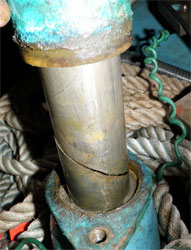 |
|
A crack was discovered in the rudder shaft. It spiraled to a point just above the lower rudder packing. |
The next day, with plenty of light, 16 knots SSE and eight-foot seas, they methodically investigated the boat’s dual helm setup. They suspected a bad steering cable was the root of the problem. Their tests concluded, however, that both quadrants and cables were fine. This analysis lead them to investigate the lower rudder packing and it was eliminated as a problem.
Vaughn, Sharon and Dan had 2,350 miles ahead of them and their options were to either hand steer Reality during three-hour watches or to use an old Fleming wind vane (which they had affectionately dubbed Peggy). Otherwise, their least desirable option would be to turn around and head back, upwind, to either Panama or Ecuador. After a few hours, with the wind and sea state stable, Peggy the wind vane was in place. After 150 miles, Peggy proved herself and the decision was made to continue to the Marquesas.
Strange noise from rudder
On day 15, sleeping in the aft cabin, Sharon was awakened by an usual noise that Vaughn had also heard on deck. The noise was coming from the rudder shaft. The bolts for the lower rudder packing had sheered off and the Hamptons were concerned about water entering the boat through the stuffing box. Quickly all hands gathered on deck.
Peggy was left to steer while Vaughn and Dan removed the sheered bolts and Sharon searched through their inventory for new bolts. Working through the night, Vaughn had to cut slots in the sheered bolts to back them out and finish the repair. With 300 miles to go, remarkably, the crew’s nerves were intact. Reality made landfall at Anaho Bay, Nuku Hiva. Despite a thorough underwater investigation of the rudder, Sharon and Vaughn continued to be baffled by the problem at the helm. The next day, Reality went into Taahuku Bay, Hiva Oa, where Dan said goodbye and flew home and Sharon and Vaughn checked in to French Polynesia.
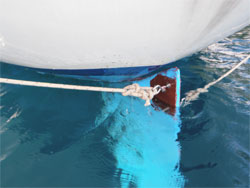 |
|
Since the broken shaft was no longer usable, a plate was bolted to either side of the rudder and lines attached to move the boat’s rudder. |
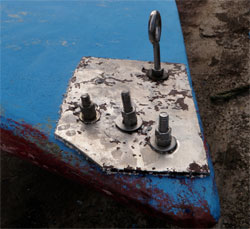 |
For those readers who have not anchored in Taahuku Bay, the anchorage is small, requires both a bow and stern anchor and the swells from the SE quadrant of the bay refract off the cliffs on the northwest side of the bay turning the bay into a washer board. After a week Vaughn and Sharon set sail for Fatu Hiva, the heaven of the Marquesas Islands. However upon entering Hana Vave Bay, Vaughn realized that he had no steerage and miraculously sailed into the bay and immediately dropped anchor.
It was in Fatu Hiva that Vaughn and Sharon finally saw the problem. A crack that started below the lower rudder packing had now spiraled its way just above the lower rudder packing. The washer board effect in Taahuku Bay must have sealed the fate on Reality’s rudder post. The post was severely cracked.
The couple’s despair was temporary, however. The cruising community and the villagers from Fatu Hiva rallied together and over the course of the next week, helped come up with a remarkably clever solution that allowed Sharon and Vaughn to safely sail Reality to Papeete where she would be refitted with a new post and rudder.
Initially a French cruiser offered articles with instructions on how to create drogues that would help steer Reality without a rudder. Vaughn and Sharon settled on two drogues; one made with a tire offered by a villager who was using it as a planter and the other made from a large canvas bag filled with rocks. Sharon sewed the bag from canvas that was in her inventory for Reality’s awnings and the rocks came from Fatu Hiva’s beach. If the drogues were necessary, they would be deployed on 300 feet of 5/8-inch line that Reality had in inventory.
A workable design
Heribert, a German cruiser on Wassabi with civil engineering skills, came over to Reality to help inspect the situation, and after a few hours, returned to Reality with drawings showing how the rudder could be rigged to be controlled from the helm. Between the villagers, the cruising community and Reality’s inventory, a spinnaker pole, blocks, lines, eye bolts, wood and tools were harvested. At least half of the work needed to be done under the waterline so a cruiser from Australia helped Vaughn by keeping him stable in the water while Vaughn applied pressure to drill holes into the rudder. Using a hand-held auger, Vaughn drilled four holes into the rudder and positioned two aluminum backing plates to mount the two eye bolts.
They attached blocks to the ends of the spinnaker pole, which was reinforced by lumber lashed along its length. Lines where then connected from each side of the rudder to its respective side of the pole, through the blocks and onto the helm. This allowed Vaughn or Sharon to steer Reality by pulling one or another of the lines.
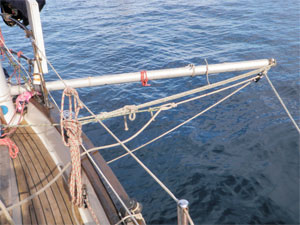 |
|
A spinnaker pole, lines and blocks were pressed into service to control the steering lines. |
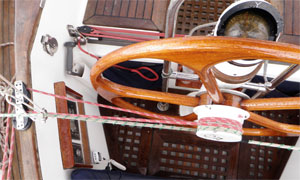 |
|
The steering lines were led into the cockpit and onto a drum on Reality’s wheel. |
Heribert’s design suggestion was to make these control lines a single loop. Then by wrapping this loop around the wheel hub, turning the wheel tightened one line while the opposition line was automatically released, thus turning the rudder.
In addition to various items that were gathered for this jury-rigged steering system, Vaughn and Sharon were able to purchase 50 gallons of fuel from the cruising community. Not knowing how well and how long this system would work with sails, Vaughn and Sharon knew that they would need to motor-sail most of the way back to Papeete, some 850 miles. Despite the additional 50 gallons, they knew they were short on fuel for the route that required they keep a wide berth around the low atolls of the Tuamotus.
After a week of planning and preparing, it was time to see if all the theoretical solutions would actually steer the boat. With the assistance of five dinghies, Sharon and Vaughn weighed anchor. Chaos ensued for the first 10 minutes as the dinghies tried to pull Reality safely out of the anchorage. A last-minute wind shift began blowing Reality back into the anchorage and near the rocky shore. The dingy team was not making headway and Reality was floundering. Vaughn and Sharon realized that the lines controlling the rudder were run the wrong way. Vaughn quickly reversed his steering, Reality cleared the rocks at the mouth of the bay and they were on their way. Once out in open water, Sharon and Vaughn reversed the rudder lines so turning to starboard actually turned Reality to starboard. With Fatu Hiva fading into the distance, Sharon and Vaughn relaxed, gaining confidence with each mile that the jury-rigged steering system was able to steer Reality.
Vaughan and Sharon safely arrived in Papeete on May 5th, sailing 850 miles in eight days without incident. They had been able to sail slowly, approximately 100 miles per day, and still had plenty of fuel in reserve.
A tug assisted their entry into the harbor and after 23 days, Reality had a new rudder and post.
——–
Fay Mark, a former high tech marketing executive, is voyaging with her partner, Russ Irwin, on New Morning, their 54-foot Chuck Paine-designed sloop. For more information about Fay, Russ, New Morning, and their cruising adventures, visit www.newmorning.info.

